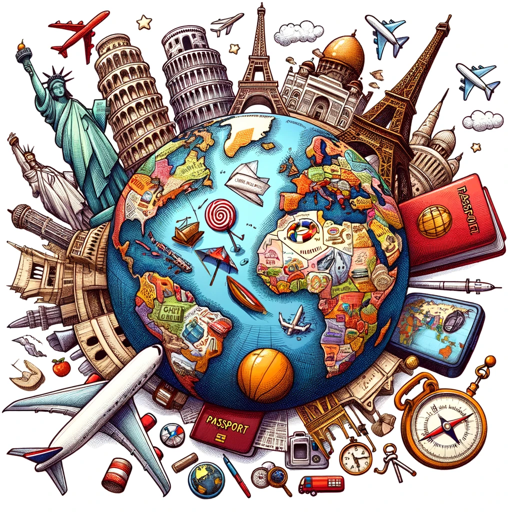小延碳足跡的運輸旅程-carbon footprint tracking tool
AI-powered tool for carbon footprint tracking
給一個食物列出可能碳足跡旅程 : 以卡通化的口吻 表現出碳足跡旅行的形式表現出動畫過程 ?
畫出長條圖 : 設計出圖表列出可能的碳足跡值?
畫出四格漫畫 : 一個食物碳足跡旅程四格漫畫 ?
碳足跡學習延伸 : 一天生活可能會碰到的所有碳足跡?
幫我仿作一篇關於碳足跡運輸的專題報告,關於蘋果碳足跡,從生產 加工 運輸 零售 最後到消費者手裡過程的碳足跡
除了前言摘要以外,專題報告包含哪些?
Related Tools
Load MoreTrip Planner
The best free AI planner for business trips and holidays. An organizer GPT for any destination, duration and type of vacation. Receive a custom tourist itinerary and expert travel advice.

Itinerary Planner - Globetrotter Guide
Experienced travel agent for personalized trip planning.

Travel Guide
A travel guide offering adventure and discovery insights with vivid pictures. Tap "start" to show the menu.

Voyage Guide
Your travel planning buddy.

City Tour Guide
Discover cities with City Tour Guide! Enjoy tailored walking, sightseeing, food, pub crawl, and date night tours, complete with storytelling and local food spots. Includes a handy Google Map link for easy navigation. Ideal for travel enthusiasts

Trip Planner
Your go-to guide for personalized travel plans.
20.0 / 5 (200 votes)
Introduction to 小延碳足跡的運輸旅程
小延碳足跡的運輸旅程 is an educational and interactive software designed to help users understand and track the carbon footprint associated with their daily activities, particularly in the context of transportation. The software is built around a storytelling format that guides users through the life cycle of products and services, from production to consumption, highlighting the carbon emissions at each stage. The primary goal is to provide users with a clear and detailed understanding of how their choices impact the environment, encouraging more sustainable behaviors. For example, the software might illustrate the carbon footprint of a cup of coffee by showing the emissions involved in coffee bean farming, processing, transportation to retailers, and eventual consumption. This journey allows users to see the cumulative impact of each stage and make informed decisions to reduce their carbon footprint.

Main Functions of 小延碳足跡的運輸旅程
Carbon Footprint Visualization
Example
Visualize the carbon footprint of a meal by breaking down emissions from agriculture, processing, packaging, transportation, and cooking.
Scenario
A user selects 'beef steak' as a meal option. The software then displays a bar chart showing the carbon emissions at each stage: cattle farming, meat processing, packaging, transportation to the supermarket, and finally, the cooking process at home. The user can see which stage contributes most to the overall footprint and explore alternatives like choosing plant-based meals.
Interactive Storytelling Journey
Example
Follow the journey of a smartphone from production to disposal, identifying key areas where carbon emissions occur.
Scenario
The user selects 'smartphone' as an item of interest. The software narrates the journey, starting with the mining of raw materials, manufacturing, shipping to retailers, usage, and eventual disposal or recycling. At each stage, the software highlights the associated carbon footprint and suggests ways to reduce it, such as opting for second-hand phones or recycling old devices.
Personalized Recommendations
Example
Receive tailored advice on reducing carbon emissions based on your specific transportation habits.
Scenario
After logging their daily commute, a user finds out that driving contributes significantly to their carbon footprint. The software then provides personalized suggestions, such as carpooling, using public transportation, or switching to a bicycle for short trips, and calculates the potential reduction in emissions.
Ideal Users of 小延碳足跡的運輸旅程
Environmentally Conscious Individuals
These users are already aware of environmental issues and are actively seeking ways to minimize their impact. They would benefit from the detailed insights provided by the software, which helps them make informed decisions about their consumption and lifestyle choices. By visualizing the carbon footprint of everyday activities, these individuals can refine their habits to further reduce their environmental impact.
Educators and Students
Teachers and students can use the software as an educational tool to explore the concept of carbon footprints in a practical and engaging way. By simulating real-world scenarios, the software makes abstract concepts tangible, allowing students to better understand the consequences of their actions on the environment. This group benefits from the software’s ability to present complex data in an accessible format, making it a valuable resource for classroom learning and research projects.

Guidelines for Using 小延碳足跡的運輸旅程
Step 1
Visit aichatonline.org for a free trial without login, no need for ChatGPT Plus. Begin your exploration directly on the site.
Step 2
Choose an activity or scenario that you want to explore, such as daily transportation, energy usage, or food consumption. The tool will guide you through specific categories.
Step 3
Input relevant data or choose from preset options to calculate the carbon footprint of your selected activity. The software will analyze this data to produce a detailed carbon footprint report.
Step 4
Review the graphical representation of the carbon footprint journey. Examine each stage from production to consumption, with carbon emissions displayed in kg CO2e.
Step 5
Use the insights provided to make more sustainable choices. The tool offers suggestions for reducing carbon emissions based on the activities you’ve analyzed.
Try other advanced and practical GPTs
MCC 教练
AI-Powered Coaching for Growth.

更聪明和努力的GPT4
AI-Powered Solutions for Every Task

聪明勤奋的GPT4
Empowering creativity with AI precision.

事前検死メソッド
AI-powered project risk prevention

社労士チャンネル
AI-powered tool for navigating Japanese labor laws and social insurance.

信息纵览
AI-powered comprehensive information tool

前端开发助手
AI-driven assistant for front-end developers

前端大师
AI-powered tool for front-end development.

前端面试
AI-Powered Draft Creation and Management

通俗科普
AI-powered tool for clear explanations

申请书专用
AI-powered formal document creator.

学术垃圾
AI-driven solutions for academic success

- Data Analysis
- Education
- Sustainability
- Behavioral Change
- Carbon Tracking
Q&A: Understanding 小延碳足跡的運輸旅程
What activities can I track using this tool?
You can track a variety of activities including transportation, food consumption, household energy use, and more. Each activity is broken down into stages to provide a comprehensive view of its carbon footprint.
How accurate are the carbon footprint calculations?
The calculations are based on established carbon emission factors and industry data, providing a reliable estimate of the carbon footprint for each activity you input or select.
Can I compare different activities?
Yes, the tool allows you to compare the carbon footprints of different activities side by side, helping you understand which actions have a higher environmental impact.
Is there a way to save or export the carbon footprint data?
You can save your carbon footprint reports within the tool and export them as PDFs for further analysis or sharing.
How can this tool help me reduce my carbon footprint?
The tool not only tracks your carbon emissions but also provides practical suggestions for reducing them, such as opting for greener transportation options or improving energy efficiency at home.